Those particular leads in the photo do not look like they're intended to stop the part from going down as far as you like. Are you sure you used the recommended hole size in the datasheet? Or did you just take the nominal dimension and use that.. I would expect the recommended size to be relatively large for such an item.
Get a set of these generic Chinese-made calipers (they're only about $10-$30 depending on where you buy them and quality). You can get higher quality ones (eg. Mitutoyo or Brown & Sharpe) but it's not really necessary and even the most expensive calipers are not suited for high precision of better than a couple thousandths of an inch (but that's good enough for drilled hole sizes).

You can also get a 1" micrometer if you need to measure things like thickness more accurately. The vernier type is cheap, electronic digital types still cost a bit more than mechanical types.
It's usually bad form to shove plastic molded bits right down to the board- there will be a differential CTE (coefficient of thermal expansion) between the X-Y of the PCB (small) and the epoxy (large) so that the part will be under stress and will tend to split open when exposed to temperature extremes. Allowing a bit of lead in there supplies some "give" so the part is not destroyed.
Edit: There is no shortage of poorly specified LED drawings- even from relatively well-known makers. For example, here is a fairly good one from Cree.

You may note that there are two lead frame variations, one with and one without the "knuckles" (as Russell mentioned in his answer), however the one without still has artifacts where the joiners from the continuous leadframes were punched out (as Curd mentioned). Unfortunately, the artifacts are not dimensioned either in size or position (and one might assume that they fit within the tolerance of the leads 0.5+/-0.1mm but I seriously doubt that is guaranteed to be true). The ones with larger knuckles have only a nominal dimension of 1.2mm, so we don't really know if a 1mm hole (for example) will allow the LED to pass through or not. The first shipment might be find and the next not, and there's no complaint one could make from the specs. Chances are a hole of 0.8mm would work, but there are no guarantees. I have other paper datasheets from really major Taiwan-based suppliers that are no better (and some are worse). The best you can do as a small quantity user is to employ the calipers (see above) on a sample and hope they don't change leadframe suppliers etc., or switch to a supplier with tighter specs.
Below is a much more tightly specified datasheet drawing (from this Panasonic datasheet) that tells you all you need to know:

I believe that the "knuckles" here (as I opined on yours) are not intended to stop the LED from going down as far as possible- they're just artifacts of the manufacturing. The maximum dimension is specified, but no minimum, so there is no guarantee. However, there's a 2mm spec that indicates that a 2mm spacing is required under the LED (at least that's my interpretation- that it's a minimum not a maximum). This is to help keep the LED from being destroyed by differential thermal coefficients of expansion, both immediately after assembly and during operation. Note that it's above the top of the "knuckles" so it's acceptable to have the "knuckles" inside the PCB.
In general, for through-hole LEDs, we have usually used mechanical jigs to hold the LEDs relatively precisely in position during soldering, even when they are hand-soldered. If you need to get down to the 2mm-ish dimension in the above drawing, you would use a relatively large hole, so it might be sloppy depending on the LED supplier of the day. Things like cylindrical standoffs sort-of work, but they're pretty sloppy even with tight PCB through holes- the bottom of the LED is not all that flat etc. Some makers use standoffs that dissolve in the cleaning operation for crude location. Fine if you don't mind additional cost, parts etc.
Edit2: By the way, if you do decide to file the leadframe, keep in mind that you'll remove the (usually Sn) plating and expose the alloy underneath (most often it is steel to keep costs down- easily checked with a magnet). Don't expect to be able to solder to the exposed leadframe core material!





